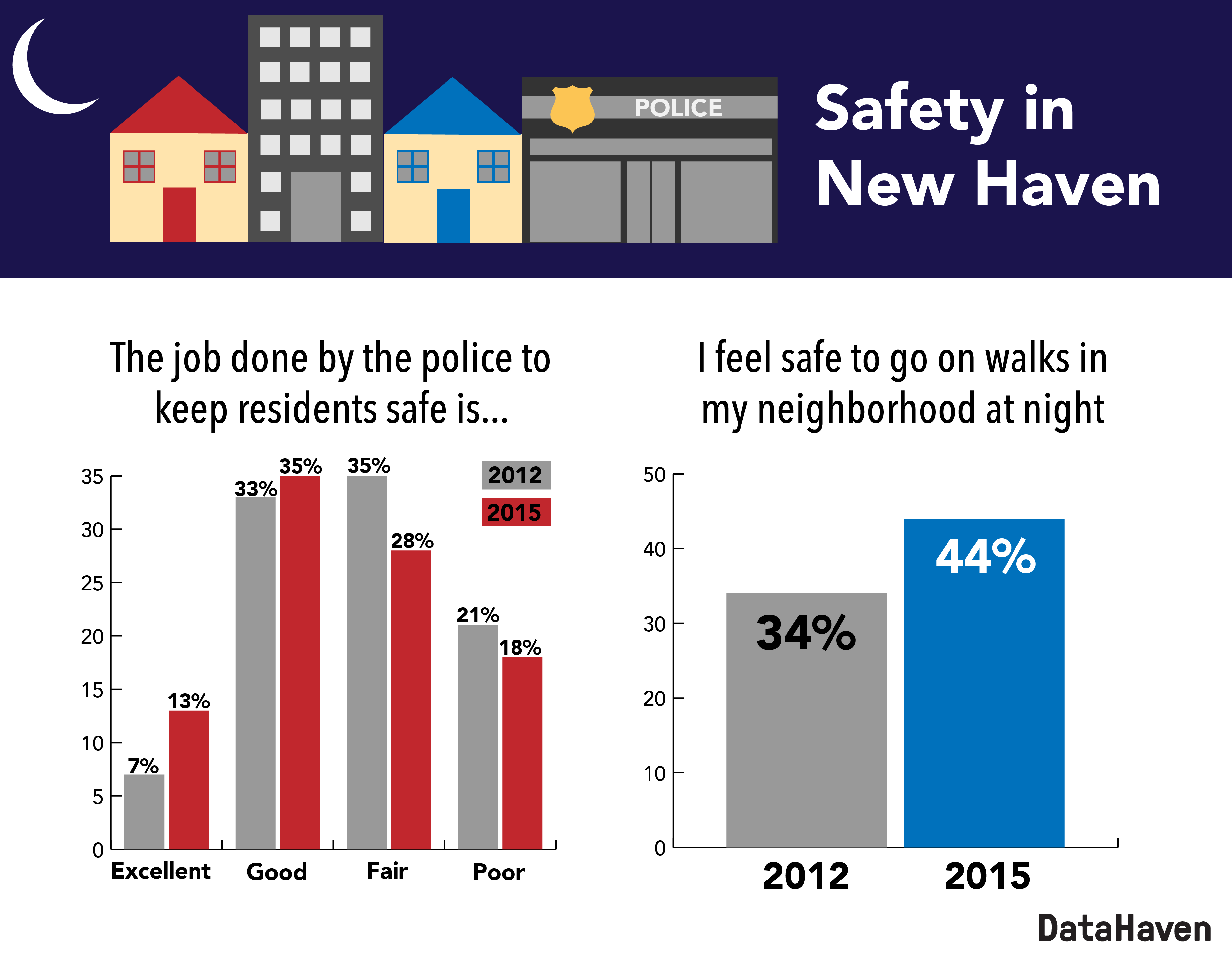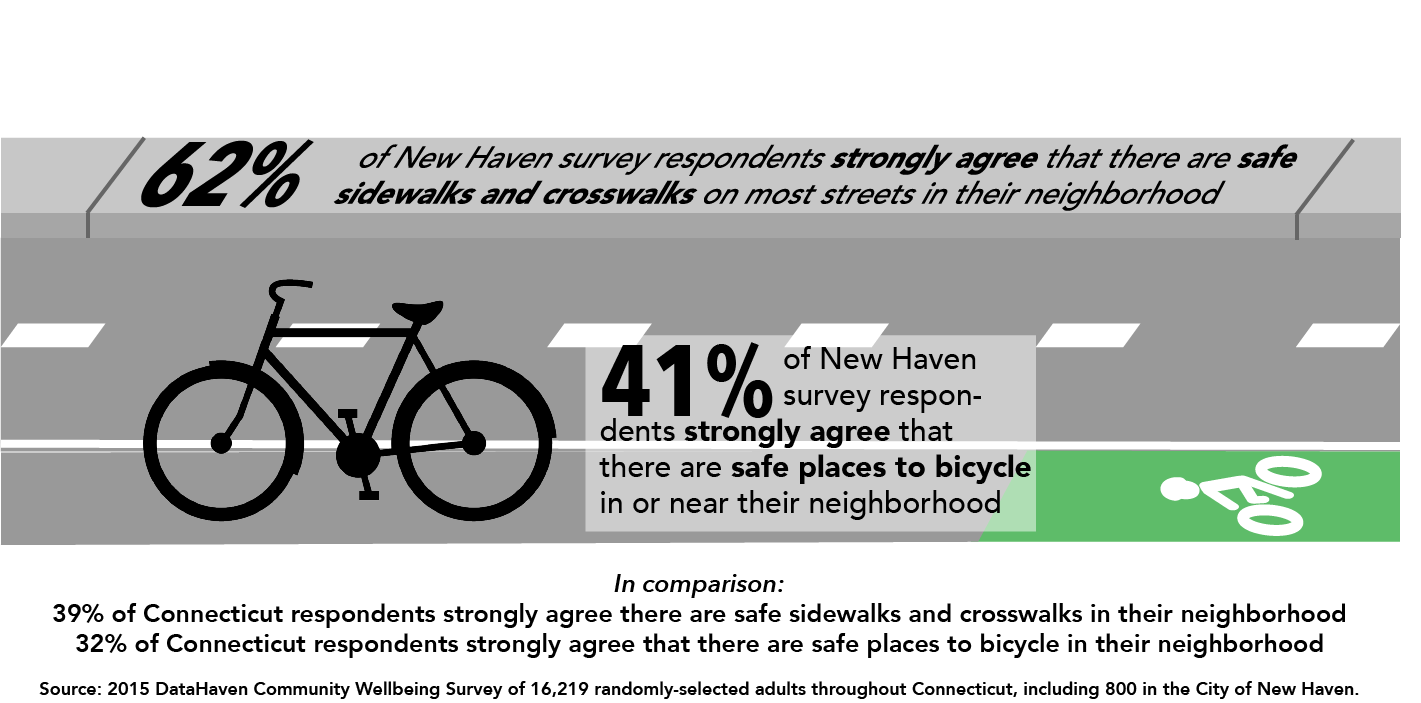All DataHaven Programs, Community Wellbeing Survey, Economy, Public Safety
New Haven Residents Feeling Somewhat Safer
This article was originally published 1/15/2016 in the New Haven Independent, https://www.newhavenindependent.org/index.php/archives/entry/data_city_residents_n/
by APARNA NATHAN AND MARK ABRAHAM
 New Haven residents feel safer in their neighborhoods than they did three years ago, one of many indicators from recent neighborhood surveys that show rising levels of optimism about the city, its government, and the local job market.
New Haven residents feel safer in their neighborhoods than they did three years ago, one of many indicators from recent neighborhood surveys that show rising levels of optimism about the city, its government, and the local job market.
Two surveys — the DataHaven Community Wellbeing Survey, which completed in-depth live cell phone and landline interviews with over 16,000 randomly-selected adults throughout Connecticut, as well as a coordinated door-to-door survey conducted by the Community Alliance for Research and Engagement (CARE) at the Yale School of Public Health of about 1,200 residents living within six low-income New Haven neighborhoods — both found that residents in New Haven now have a significantly improved feeling of safety in their own neighborhoods when compared to those who responded to nearly-identical surveys conducted in mid-2012.
The DataHaven Community Wellbeing Survey also found that respondents in the City of New Haven had an improved perception of the effectiveness of the police in 2015, when compared to respondents in 2012.
A total of 44 percent of all adults in the City of New Haven (age 18 and over) reported feeling at least somewhat safe to go on walks in their neighborhoods at night in 2015, a significant increase from the 34 percent who reported the same in 2012, according to the DataHaven survey. The CARE survey found a similar change in the perceptions of surveyed adults age 18 to 65 living in six of the city’s lower-income neighborhoods. In comparison, 71 percent of residents statewide said that they felt at least somewhat safe to walk at night.
Similarly, 48 percent of New Haven adults felt that the local police are doing an excellent or good job keeping residents safe in 2015, in comparison to 40 percent in 2012, according to DataHaven. While this is still much lower than the 92 percent rating given by residents in the state’s wealthiest towns, it represents a significant improvement that likely reflects a decreased rate of serious violent crime in New Haven over the past few years.
Relative to the statewide averages, the poorer perceptions of safety in the City of New Haven match objective data from the DataHaven survey and other sources — for example, in 2015, 8 percent of all adults living throughout New Haven said that they had been attacked or threatened at least once in the past year, and 15 percent had been the victim of a property crime. These victimization rates were about twice the rate of other residents in Connecticut, where the survey found victimization rates of 4 percent for violent crime and 9 percent for property crime, respectively. In New Haven and statewide, about half of those respondents who were attacked or threatened said that the incident(s) were never reported to the police, and about half of crimes involved someone that the respondent knew or worked with.

Survey respondents were also asked to think about the safety of their neighborhoods from a different perspective — in terms of road safety. When asked about their neighborhoods, 62 percent of New Haven residents strongly agree that there are safe sidewalks and crosswalks on most of the streets, and 41 percent strongly agree that there are places to bicycle. In 2012, only 54 percent and 28 percent of respondents strongly agreed that there were safe places to walk and bike, respectively. These rates of perceived bikeability and walkability were significantly higher than those reported statewide, and higher than those in Connecticut’s other city centers.
This year’s survey also revealed major changes in other key areas of economic well-being — changes that may also have a positive impact on residents’ broader perceptions of safety and security. For example, food insecurity decreased for city residents by 9 percentage points in both the DataHaven and the CARE survey, yet 22 percent of citywide respondents, including one in three residents in low-income neighborhoods, still reported that they could not always afford food for themselves or their families in 2015 (a decrease from 31 percent citywide in 2012). Similarly, under-employment rates within the labor force, a figure that includes workers and potential workers who wish to work as well as those who are working part-time but would rather have a full-time job, also declined citywide, from 32 percent in 2012 to 20 percent in 2015. Additionally, though the survey reveals that many groups continue to experience serious barriers to obtaining medical care, the proportion of all adults throughout the City of New Haven who reported not having health insurance declined substantially from 2012 to 2015, from 13 percent in 2012 to 8 percent in 2015, similar to the statewide trend.
DataHaven and its statewide partners plan to release more detailed findings, including neighborhood-level results, through reports and public events throughout the year, including the 2016 Connecticut Civic Health Index to be released in Hartford on January 19th. An 18-minute segment on Where We Live last week provides an overview of what is believed to be the largest neighborhood-level well-being survey in the United States.
Aparna Nathan is Research Intern and Mark Abraham is Executive Director at DataHaven, a formal partner of the National Neighborhood Indicators Partnership with a 25-year history of public service to Greater New Haven and Connecticut. DataHaven’s mission is to improve quality of life by collecting, sharing and interpreting public data for effective decision making.
Originally posted on January 15, 2016, at: http://www.newhavenindependent.org/index.php/archives/entry/data_city_re…
